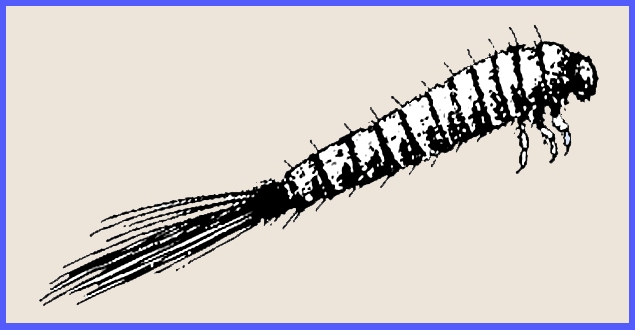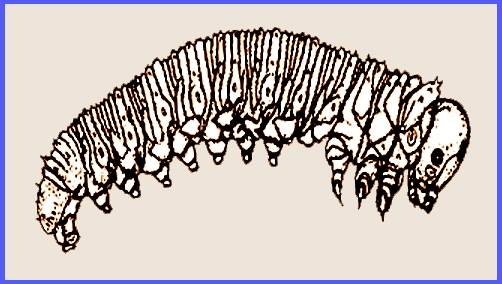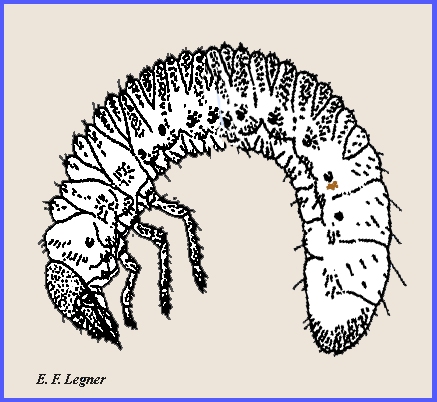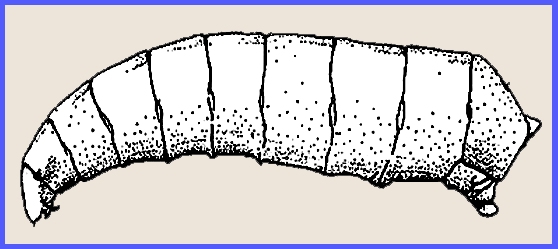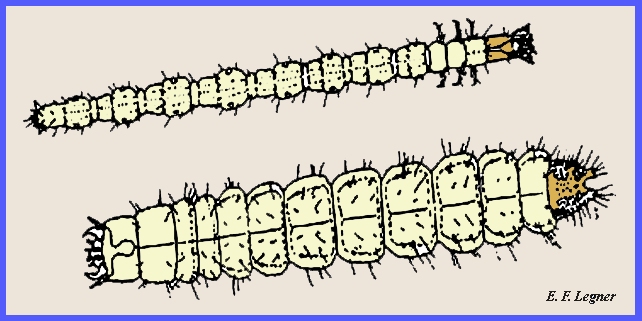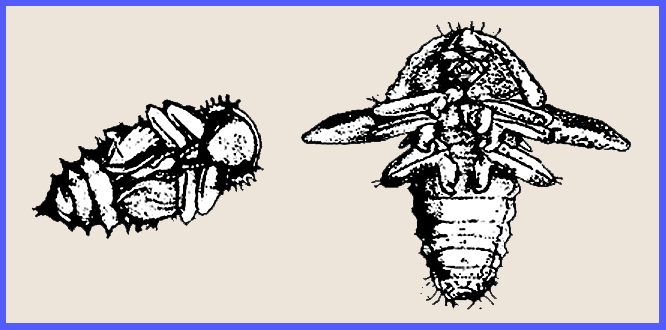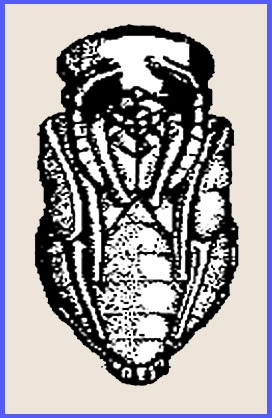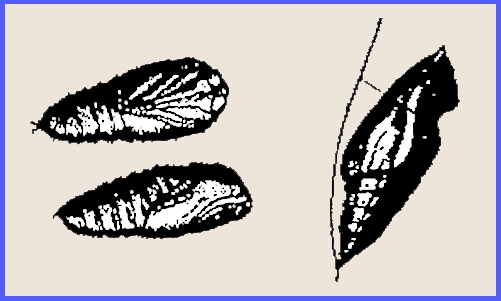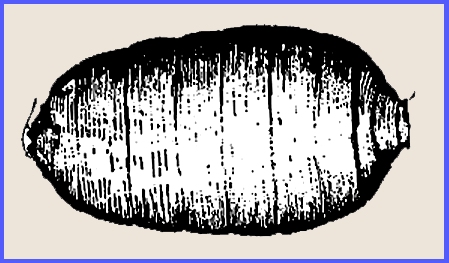File:
<metamorphosis.htm> < (Entomology), (Invertebrates),
(General Index)> <Invertebrate
Bibliography> <Glossary> <Site Description> < Home>
Introduction Contents►
|
Entomology: METAMORPHOSIS
1 Kingdom: Animalia, Phylum: Arthropoda Subphylum: Hexapoda: Class: Insecta: Entomology Metamorphosis (Contact) Please CLICK on underlined
categories to view and on included illustrations to enlarge: Depress Ctrl/F to search for
subject matter: |
|
General
Characteristics of Metamorphosis Insects attain maximum size by
undergoing a succession of molts or ecdyses. The number of molts that an insect
passes through is quite constant for the species, and the form assumed by the
animal between any two ecdyses is called an instar. The animal's existence is thus made up of a
succession of instars (growth) during which the insect is immature, followed
by the attainment of the final adult instar (metamorphosis). In the
simplest and most generalized insects the instars resemble one another and
only differ from the adult in the absence of wings and the incomplete
development of the reproductive system. Where the adult is primitively
wingless, as in silverfish and springtails the change from young to adult is
so slight as to be ignored, and metamorphosis, involving only a development
of the reproductive system, is usually considered to be absent. The insect
orders in this category may be grouped under the Ametabola.
This resting stage is really one
of much physiological and developmental activity, and it is here that many
larval tissues, e.g. the muscles and the alimentary canal, are broken down by
phagocytic or other processes and the new adult tissue is constructed from
many growth centers, usually called imaginal discs. The
change from larva to pupa is often accompanied by a period of inactivity at
the end of the last larval instar. The origin of the phenomenon of holometaboly
is vague. That it is associated with divergent specializations of larvae
and adults in varying degrees is from observation. Therefore, it is not unexpected to find among the orders
composing this group, as, for instance, in many Coleoptera, larvae that are
nymph-like in that they are well cuticularized and have well-developed legs,
and mouthparts resembling those of the adults.
The molting which result is the
route by which either further juvenile stages or the final adult stage can be
attained. In the presence of the secretion of the corpora allata the juvenile
condition results. When these glands
stop functioning, usually at the end of the larval period, the molting
process, still activated by the prothoracic gland, gives rise to the adult. ------------------------------------------- There are four types of metamorphosis (1) Ametabolous, (2)
Paurometabolous, (3) Hemimetabolous and (4) Holometabolous. Ametabolous
Metamorphosis. -- In this type the only
appreciable difference from the immature to the adult is the maturation of
the sex organs (e.g., silverfish) Paurometabolous
Metamorphosis. -- Here the various
mymphs closely resemble the adult except for body proportions. The steps are egg to nymphs to adult
(e.g., grasshopper, milkweed bug). Hemimetabolous
Metamorphosis. -- All the
Hemimetabolaare aquatic. The steps
are egg to naiad to adult. The naiad
is very different from the adult in appearance (e.g., dragonfly, mayfly,
stonefly). The wings are developed externally
in both the hemi- and paurometabolous insects, and these two are often
considered together under the Paurometabola.
The developing wing is called a wingpad. Holometabolous
Metamorphosis. -- Here the steps are
egg to larva to pupa and adult. Wings
are developed internally beneath the cuticula. The pupal is often called the "resting stage," but
this in inaccurate because thee is a complete histolysis of larval tissues
and a reconstruction to the adult. There are five larval types found in the Holometabola: Campodeiform
larvae
are extremely active and
usually predatory. They have a
flattened body with a prognathous head, and their thoracic legs are well
developed for running. Their jaws are
designed for cutting and tearing.
Their cerci and antennae are often well developed (e.g., many beetles,
neuropterans and trichopterans: Fig. ent73).
Eruciform larvae are
the opposite of campodeiform by being sluggish, like caterpillars. They have a hypognathous round body. The head is well developed but with very
short antennae, and with thoracic legs and abdominal prolegs (e.g.,
Lepidoptera, Mecoptera and some Hymenoptera: Fig. ent70). Scarabaeiform larvae
inhabit the soil or plant tissues, and some species are enclosed in
tunnels. They are quite helpless
grubs especially when exposed on the surface of the soil. They are hypognathous with a usually
curved body (e.g., June beetle: Fig. ent72). Vermiform
larvae are very advanced with a
reduced head. The body is elongated
and wormlike, legless (e.g., maggots: Fig. ent71). Elateriform larvae are prognathous with a
hard and elongated cylindrical body (e.g., wireworms: Fig. ent74) ------------------------------------------- The adult is the perfect or sexual
stage of an insect. In this stage the
sexual organs mature and locomotory appendages are sufficient for
propagation. The storage of energy varies
considerably among species. Some
adults can only take water or liquid; some adults use fat bodies that were
stored in a previous immature stage, and some, like chironomid midges, cannot
even imbibe liquids. Much of
metamorphosis is directed toward producing an adult that can propagate the
species. Types of Reproduction.
-- Adult insects show various types of reproduction. In oviporous reproduction an egg is
formed and the female lays the egg covered by a chorion. In polyembryony there is a lot of
division in the egg to give many individuals from one egg. In vivipary the insect is born
alive although its origin was still from an egg. In parthenogenesis the young are produced form infertile eggs,
as in aphids. Some species do not
have males, as in the white-fringed beetle.
Some may have a combination of fertile and infertile periods. Paedogenesis involves
reproduction in immature stages. The
maggot young fasten themselves on the parent and consume them. Several generations may pass in this
manner. Egg Shape Variation.
-- The various kinds of sculpturing found on insect eggs are formed by
epithelial cells. Many insects have the means of
fixing their eggs so that they will have a proper environment for
development. Examples are nits, the
eggs of lice, that are glued to the hair of their host and the ovipositor can
cut holes into wood where the eggs are laid.
Lacewings lay their eggs on a stalk, which is a piece of silk with the
egg attached to the end. However,
some insects depend wholly on large numbers of eggs for survival of the
species. Molting
Process. -- The entire cuticle is
cast off and a new one is formed.
This includes lenses of the eyes, mandibles, linings of the fore and
hind guts, tracheal trunks and linings of the genital chamber. Hypodermal cells must lay down the new
cuticula. At the same time the cells
must secrete a fluid, which will erode away much of the endocuticle. This can be resorbed by the hypodermal
cells and used again. When most of
the cuticula has eroded away the insect can molt. New cuticula is very soft and pliable. It remains so for several hours before
being oxidized during which time it can be expanded to accomodate the larger
size of the insect. When the insect
casts its skin, the integument underneath is not pigmented and it remains
white for an hour or more. The instar is
the form of an insect after the molt.
Following egg hatching there can be a first, second and more
molts. The number of instars varies
but it is normally four. Some insects
can regress in molting (e.g., carpet beetle). ------------------------------------------- The pupa is an immature stage in
development of the Holometabola. It
is a stage of quiescence primarily even though there can be some movement as
is typical of mosquitoes. It is also
the stage of breakdown of tissue and the buildup of others. Various other names often assigned to this
stage are chrysalis,
puparium and
cocoon. There are three types of pupae: (1) exarate,
where the developing wings, mouthparts and legs are visible externally (e.g.,
Hymenoptera and Coleoptera: Figs. ent75 & ent76). (2) obtect,
where the mouthparts, legs and wings are seen as incompletely formed
structures glued down as an integral part of the pupal case (e.g.,
Lepidoptera: Fig. ent77). (3) coarctate, where an exarate pupa is
formed within the last larval skin.
The exterior is generally smooth and seedlike (e.g., Diptera: Fig. ent78).
============= |
Introduction Contents►
